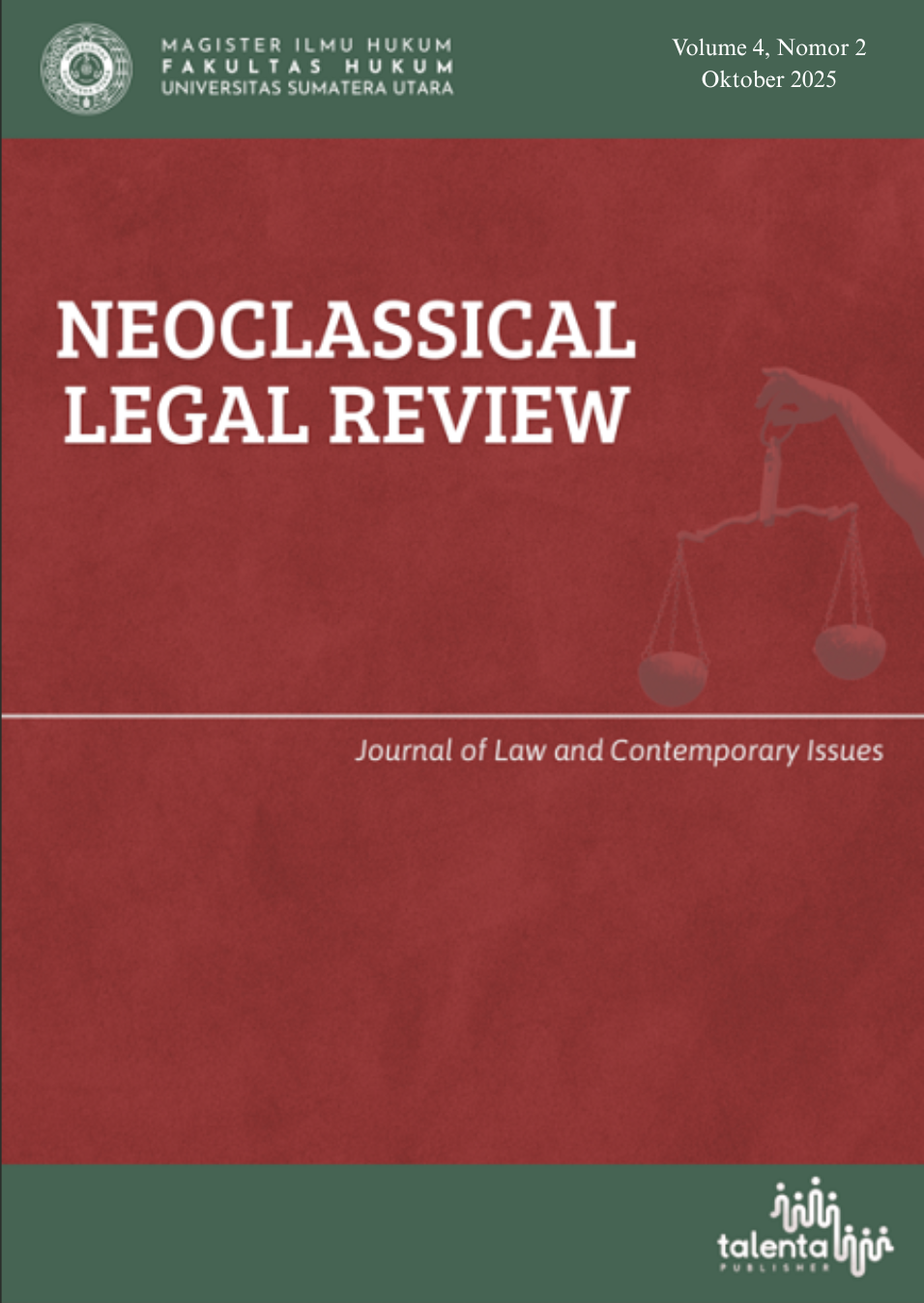Political Economy’s Influence on ASEAN’s Competition Law: A Study on Selected ASEAN Members
Pengaruh Ekonomi Politik terhadap Hukum Persaingan ASEAN: Studi pada Beberapa Anggota ASEAN Tertentu
DOI:
https://doi.org/10.32734/nlrjolci.v4i2.20845Keywords:
Political Economy, Exemption, Integration, Competition LawAbstract
Competition law aims to promote fair market practices and prevent monopolistic behaviour, while political economy explores the relationship between economic systems and political institutions. Together, these disciplines shape the regulatory frameworks that oversee national markets and economic policies, encouraging competition and tackling issues such as inequality and market inefficiencies. In developing countries, the influence of political economy tends to be more significant than in developed nations, which usually benefit from more stable democratic institutions and stronger legal systems. Among ASEAN member states (AMS), there is notable variation in levels of economic development, policies, political structures, and legal frameworks. Consequently, each AMS’s unique political and legal history has influenced its approach to economic management and competition law, leading to distinct priorities and concerns. These political economy factors similarly impact the process of regional competition law integration among ASEAN countries. This paper explores how political economy shaped the enactment and enforcement of competition law in selected AMS: Malaysia, Vietnam, Thailand, and Indonesia. It analyses the underlying reasons for their specific reservations, exemptions, and priorities within their competition law. Using qualitative legal research and comparative analysis, the study reviews relevant political economy structures, statutes, regulations, and policies in the chosen AMS to assess their significance and influence on competition law administration. The findings indicate that ASEAN’s regional competition law alignment and integration must recognise each AMS’s broader internal political economy, which is vital for developing competitive markets within ASEAN.
Downloads
References
Ahamat, H., & Rahman, N. A. (2017). State-Owned Enterprises, Market Competition and the Boundaries of Competition Law in Malaysia. Jurnal Pengurusan, 51(1), 1–10. https://doi.org/10.17576/pengurusan-2018-51-15
Alam, Moch. Z., & Tejomurti, K. (2022). Are the Interests of Business Actors and Consumers Balanced in the Indonesian Competition Law? Dialogia Iuridica, 14(1), 095–123. https://doi.org/10.28932/di.v14i1.5114
Allen, G. C., & Donnithorne, A. G. (2013). Western Enterprise in Indonesia and Malaysia (1st ed.). Routledge. https://doi.org/10.4324/9781315016306
Andreoni, A., & Chang, H.-J. (2019). The Political Economy of Industrial Policy: Structural Interdependencies, Policy Alignment and Conflict Management. Structural Change and Economic Dynamics, 48, 136–150. https://doi.org/10.1016/j.strueco.2018.10.007
Antipa, P., & Bignon, V. (2019). Whither Economic History? Between Narratives and Quantification. Revue de l’OFCE, 157(3), 17–36. https://doi.org/10.3917/reof.157.0017
ASEAN (Ed.). (2008). ASEAN Economic Community Blueprint. ASEAN Secretariat.
ASEAN (Ed.). (2010). ASEAN Regional Guidelines on Competition Policy. Association of Southeast Asian Nations.
ASEAN. (2015). Economic Community [Official Website]. Association of Southeast Asian Nations. https://asean.org/our-communities/economic-community/
ASEAN. (2020). Study on Commonalities and Differences across Competition Legislation in ASEAN and Areas Feasible for Regional Convergence (2nd ed.). ASEAN Secretariat.
Athukorala, P.-C. (2011). Foreign Direct Investment in Malaysia: Historical and Contemporary Perspectives [Website Article]. Economic History Malaysia. https://www.ehm.my/publications/articles/foreign-direct-investment-in-malaysia-historical-and-contemporary-perspectives
Cropsey, J. (2021). Polity and Economy: An Interpretation of the Principles of Adam Smith (With Further Thoughts on the Principles of Adam Smith) (Revised). St. Augustine Press.
Damanik, I., Rompas, A., Nadia, Z., Berenschot, W., & Warburton, E. (2025). Business-Politics Relations in Indonesia: The Oligarchisation of Democracy. Bulletin of Indonesian Economic Studies, 61(1), 39–60. https://doi.org/10.1080/00074918.2024.2442417
Daniels, R. J., & Trebilcock, M. (2004). The Political Economy of Rule of Law Reform in Developing Countries. Michigan Journal of International Law, 26(1), 99–140.
Dowdle, M. W., Gillespie, J., & Maher, I. (Eds.). (2013). The Political Economy of Global Competition Law. In Asian Capitalism and the Regulation of Competition: Towards a Regulatory Geography of Global Competition Law (pp. 53–120). Cambridge University Press; Cambridge Core. https://www.cambridge.org/core/product/EA48F69EED493E1A19855A6536CA5B0E
Faaland, J., Parkinson, J. R., & Saniman, R. (1990). Growth and ethnic inequality: Malaysia’s new economic policy. Dewan Bahasa dan Pustaka in association with Chr. Michelsen Institute, Bergen, Norway.
Feng, Y. (1997). Democracy, Political Stability and Economic Growth. British Journal of Political Science, 27(3), 391–418. https://doi.org/10.1017/S0007123497000197
Fox, E. M., & Bakhoum, M. (2019). Making Markets Work for Africa: Markets, Development, and Competition Law in Sub-Saharan Africa. Oxford University Press USA - OSO.
Godek, P. E. (1992). Antitrust: One U.S. Export Eastern Europe Doesn’t Need (Reprinted). International Merger Law - Regulation.
Hayes, A. (2025). Economics Defined with Types, Indicators, and Systems [Website Article]. Investopedia. https://www.investopedia.com/terms/e/economics.asp
Jesudason, J. V. (1989). Ethnicity and the Economy: The State, Chinese Business, and Multinationals in Malaysia. Oxford University Press.
Juhász, R., & Lane, N. (2024). The Political Economy of Industrial Policy. Journal of Economic Perspectives, 38(4), 27–54. https://doi.org/10.2139/ssrn.4823810
Kovacic, W. E. (2007). Lucky Trip? Perspectives From a Foreign Advisor on Competition Policy, Development and Technical Assistance. European Competition Journal, 3(2), 319–328. https://doi.org/10.5235/ecj.v3n2.319
KPPU. (2019). KPPU, Saudara Tua Otoritas Persaingan ASEAN [Official Website]. Komisi Pengawas Persaingan Usaha. https://kppu.go.id/kppu-saudara-tua-otoritas-persaingan-asean/
Kwik, K. G., Utomo, Y. P., & Purnomo, J. D. H. (1999). Ekonomi Indonesia dalam krisis dan transisi politik (1st ed.). Gramedia Pustaka Utama.
Law on Competition No. 23/2018/QH14, Pub. L. No. 23/2018/QH14 (2018). https://thuvienphapluat.vn/van-ban/EN/Doanh-nghiep/Law-23-2018-QH14-on-competition/387952/tieng-anh.aspx
Len, D. (2006). A Comparative Study of Competition Law: What’s in Store for Malaysia? CLJ I., 2.
Lianos, I. (2024). A Law and Political Economy Approach to Ecosystems and Competition Law. SSRN. https://doi.org/10.2139/ssrn.5015913
Lianós, I., & Sokol, D. D. (2012). The Global Limits of Competition Law. Stanford Law Books.
Maria, R. Sta., Urata, S., Intal, P. S., & Economic Research Institute for ASEAN and East Asia (Eds.). (2017). The ASEAN Community into 2025 and Beyond. ERIA.
McEwin, R. I., & Thanitcul, S. (2013). The Political Economy of Competition Law in Asia (M. Williams, Ed.). Edward Elgar Publishing. https://doi.org/10.4337/9781781001684
Ng, W. (2018). The Political Economy of Competition Law in China (1st ed.). Cambridge University Press. https://doi.org/10.1017/9781316658949
Nikomborirak, D. (2006). Political Economy of Competition Law: The Case of Thailand, The Symposium on Competition Law and Policy in Developing Countries. Northwestern Journal of International Law & Business, 26(3), 597–618.
Porananond, P., & Aung, P. M. M. (2019). Emerging Trend in Competition Law in Southeast Asia: Perspectives from Myanmar and Thailand. World Competition, 42(Issue 4), 577–602. https://doi.org/10.54648/WOCO2019030
Price Control and Anti Profiteering Regulations 2018 (2018). https://www.kpdnhep.gov.my/en/trade/penguatkuasaan/penguatkuasaan-akta-kawalan-harga-dan-anti-pencatutan/price-control-and-anti-profiteering-enforcement.html
Ramaiah, A. K. (2015). Competition Law and Exemption Policy in Malaysia: When, Why and Why Not? International Journal of Business, Economics and Law, 8(4), 80–87.
Rennie, J. (2009). The Evolution of Competition Law in Singapore and Thailand and Its Implications for Bilateral Competition Policy in SAFTA and TAFTA. Int. T.L.R., 15(1).
Sivalingam, G. (2006). Competition Policy and Law in Asean. The Singapore Economic Review, 51(02), 241–265. https://doi.org/10.1142/S0217590806002354
Smith, A. (2022). The Wealth of Nations. Routledge.
Sundarman, J. K. (2004). The New Economic Policy and Interethnic Relations in Malaysia. Identities, Conflict and Cohesion Programme Paper, 1–21.
The World Bank. (2006). Overview of the capital markets in Vietnam and directions for development (World Bank Report No. 69970). The World Bank. https://documents.worldbank.org/en/publication/documents-reports/documentdetail/799361468350165858
Veseth, M. A., & Balaam, D. N. (2025). Political Economy [Article History]. Britannica. https://www.britannica.com/money/political-economy
Wagner, R. E., & Yazigi, D. (2012). Competition and Selection in Political Economy. SSRN Electronic Journal. https://doi.org/10.2139/ssrn.2154586
Wassum, M. (2023). The Political Economy of Competition Policy: Varieties of Competition Policy Approaches [Doctoral Thesis, University of Strathclyde]. https://doi.org/10.48730/X5CR-FY68
Weinstein, J. R. (n.d.). Adam Smith (1723—1790) [Article Website]. Internet Encyclopedia of Philosophy. https://iep.utm.edu/smith/
Wheelwright, E. L. (1965). Industrialization in Malaysia. Melbourne University Press; Cambridge University Press; WorldCat.
Downloads
Published
How to Cite
Issue
Section
License
Copyright (c) 2025 Angayar Kanni Ramaiah, Safinaz Mohd. Hussein, Ploykaew Porananond, Tran Viet Dung, Ningrum Natasya Sirait, Wan Liza Amin

This work is licensed under a Creative Commons Attribution-ShareAlike 4.0 International License.










